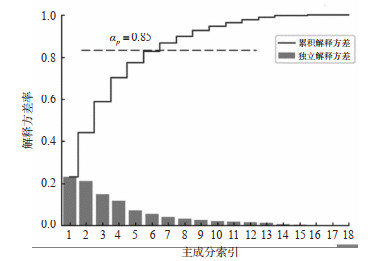Feature Selection for Recognition of Driving Styles Based on Multi-Classification and Supervised Learning
-
摘要:
交通事故与驾驶风格具有强烈的相关性,而驾驶风格的直观体现是驾驶行为。为深入分析驾驶行为与驾驶风格的关联性,探索不同驾驶风格群体之间的差异,筛选驾驶风格分类与识别影响因素,建立驾驶风格识别模型并验证有效性。依托车联网实验数据,利用K-means++算法对驾驶员样本数据集进行驾驶风格聚类,设计支持向量机-递归特征消除(SVC-RFE)与随机森林-递归特征消除(RF-RFE)算法进行驾驶特征重要度排序,利用筛选出的特征指标搭建神经网络驾驶风格识别模型。结果表明:①特征个数n = 6时,2种特征排序算法的排序正确率均高于85%,其中RF-RFE的正确率可达90%;②特征排序中重要度最高的指标为最大速度,其在3种驾驶风格群体中的差异可达10 m/s;③仅以最大速度作为输入,驾驶风格识别模型精度为86.1%,表明最大速度可有效区分驾驶风格。
Abstract:Traffic accidents are strongly correlated with driving style, and driving style can be intuitively represented by driving behavior. In order to further advance understanding of the relationship between driving behavior and driving style, this paper explores thedifferences between driving styles and identifies factors that affect the classification. A driving-style recognition model is then proposed and evaluated. Based on the experimental data from connected vehicles, a K-means++ algorithm is proposed and used to classify data of driving behavior under different driving styles and a support vector machine-recursive feature elimination(SVC-RFE)and a random forest-recursive feature elimination(RF-RFE)algorithm are used to rank the importance of features of driving behavior. A classification model for driving styles based on neural network and the above selected features is developed. The results show that: ①when the number of selected features is set as n = 6, the correct ranking rate of both feature ranking algorithms is above 85% and the correct rate of the RF-RFEalgorithm is up to 90%.②The indicator with the highest importance in feature ranking is the maximum speed, and its difference among the three driving style groups is up to 10 m/s. ③When only the maximum speed is used as input, the accuracy of the driving-style recognition model is 86.1% and therefore, it can be concluded that maximum speed can effectively distinguish driving styles.
-
Key words:
- traffic engineering /
- feature sorting /
- recursive feature elimination /
- driving style /
- traffic safety
-
表 1 驾驶风格量化指标集
Table 1. Driving style quantitative index set
序号 评价指标 序号 评价指标 1 平均车速/(m/s) 10 最小横向加速度/(m/s2) 2 最大车速/(m/s) 11 平均垂向加速度/(m/s2) 3 最小车速/(m/s) 12 最大垂向加速度/(m/s2) 4 速度标准差/(m/s) 13 最小垂向加速度/(m/s2) 5 平均纵向加速度/(m/s2) 14 平均偏航率/((°)/s) 6 最大纵向加速度/(m/s2) 15 偏航率标准差/((°)/s) 7 最小纵向加速度/(m/s2) 16 纵向冲击度平均值/(m/s3) 8 平均横向加速度/(m/s2) 17 垂向冲击度平均值/(m/s3) 9 最大横向加速度/(m/s2) 18 行程距离/m 表 2 各主成分的信息贡献率与累积贡献率
Table 2. Information Contribution Rate and Cumulative Contribution Rate of Each Principal Component
单位: % 主成分 信息贡献率bj 累积贡献率α 第1主成分 24.2 24.2 第2主成分 21.9 46.1 第3主成分 15.0 61.1 第4主成分 12.5 73.6 第5主成分 7.4 81.0 第6主成分 4.0 85.0 表 3 驾驶员主成分得分
Table 3. Driver principal component score
测试
样本第1
主成分第2
主成分第3
主成分第4
主成分第5
主成分第6
主成分样本1 -0.147 -0.738 -1.055 -1.664 -10.172 6.380 样本2 0.097 -0.814 -0.964 -1.235 -2.273 2.066 ︙ ︙ ︙ ︙ ︙ ︙ ︙ 样本241 -2.667 0.165 4.557 -0.116 -9.724 2.030 样本242 0.325 2.938 3.062 2.356 -13.067 8.413 表 4 各指标的因子载荷量
Table 4. Factor load of each index
指标 第1
主成分第2
主成分第3
主成分第4
主成分第5
主成分第6
主成分指标1 -0.399 -0.005 0.007 0.875 -0.015 0.001 指标2 -0.559 0.420 -0.133 0.608 0.237 -0.034 指标3 0.309 -0.565 0.275 0.508 -0.291 -0.169 指标4 -0.428 0.676 -0.220 -0.014 0.436 0.006 指标5 0.246 -0.284 -0.513 0.240 0.023 -0.137 指标6 -0.389 0.510 -0.412 -0.059 -0.342 -0.253 指标7 0.394 -0.525 0.256 0.170 0.404 0.254 指标8 0.705 0.639 -0.005 0.210 -0.175 -0.022 指标9 0.696 0.646 -0.010 0.218 -0.172 0.003 指标10 0.710 0.632 0.000 0.208 -0.173 -0.049 指标11 0.669 0.404 0.114 0.225 0.356 -0.100 指标12 -0.178 -0.357 0.112 0.047 0.151 -0.836 指标13 0.586 -0.228 0.279 0.127 0.493 -0.083 指标14 -0.371 0.384 0.653 0.007 0.033 -0.084 指标15 0.131 0.515 -0.212 -0.497 0.369 -0.184 指标16 -0.335 0.366 0.841 -0.075 -0.048 -0.018 指标17 0.228 -0.262 -0.833 0.040 0.106 -0.008 指标18 -0.647 0.185 -0.226 0.392 0.165 0.194 表 5 K-means与K-means++聚类效果
Table 5. Clustering effect of K-means and K-means++
方法类型 聚类数K 迭代次数 轮廓系数 K-means 3 16 0.339 4762 K-means++ 3 16 0.349 6989 表 6 SVC-RFE与RF-RFE排名前6的特征及重要性分值
Table 6. Top 6 characteristics and importance scores of SVC-RFE and RF-RFE
SVC-RFE RF-RFE 特征变量 重要度分值 特征变量 重要度分值 平均纵向加速度 4.979 最大速度 0.086 7 垂向加速度平均值 2.290 最小垂向加速度 0.021 0 速度标准差 1.786 最小纵向加速度 0.020 5 最小纵向加速度 0.909 速度标准差 0.014 6 最小垂向加速度 0.706 距离 0.012 9 最大速度 0.207 平均速度 0.009 0 -
[1] 国家统计局. 中国统计年鉴2019[M]: 中国统计出版社, 2020.National Bureau of Statistics of China. China statistical yearbook 2019[M]: Beijing: China Statistics Press, 2020. (in Chinese) [2] 郭孜政. 驾驶行为险态辨识理论与方法[D]. 成都: 西南交通大学, 2009.GUO Z Z. Theories and methods on driving risk status identification[D]. Chengdu: Southwest Jiaotong University, 2009. (in Chinese) [3] American Automobile Association. Aggressive driving: Research update[J]. American Automobile Association Foundation for Traffic Safety, 2009: 5-6. [4] CARSTEN O, KIRCHER K, JAMSON S. Vehicle-based studies of driving in the real world: The hard truth?[J]. Accident Analysis & Prevention, 2013(58): 162-74. [5] 侯海晶, 金立生, 关志伟, 等. 驾驶风格对驾驶行为的影响[J]. 中国公路学报, 2018, 31(4): 18-27. https://www.cnki.com.cn/Article/CJFDTOTAL-ZGGL201804004.htmHOU H J, JIN L S, GUAN Z W, et al. Effects of driving style on driver behavior[J]. China Journal of Highway and Transport, 2018, 31(4): 18-27. (in Chinese) https://www.cnki.com.cn/Article/CJFDTOTAL-ZGGL201804004.htm [6] YI D W, SU J Y, LIU C J, et al. A machine learning based personalized system for driving state recognition[J]. Transportation Research Part C: Emerging Technologies, 2019, 105: 241-261. doi: 10.1016/j.trc.2019.05.042 [7] OUALI T, SHAH N, KIM B, et al. Driving style identification algorithm with real-world data based on satistical approach[C]. SAE 2016 World Congress and Exhibition, Detroit, Michigan, U.S. : SAE International, 2016. [8] 孙龙, 常若松. 驾驶风格研究现状与展望[J]. 人类工效学, 2013, 19(4): 92-95. https://www.cnki.com.cn/Article/CJFDTOTAL-XIAO201304024.htmSUN L, CHANG R S. Research status and prospect of driving style[J]. Ergonomics, 2013, 19(4): 92-95. (in Chinese) https://www.cnki.com.cn/Article/CJFDTOTAL-XIAO201304024.htm [9] WANG X, XU X. Assessing the relationship between self-reported driving behaviors and driver risk using a naturalistic driving study[J]. Accident Analysis & Prevention, 2019 (128): 8-16. [10] PADILLA J L, CASTRO C, DONCEL P, et al. Adaptation of the multidimensional driving styles inventory for Spanish drivers: convergent and predictive validity evidence for detecting safe and unsafe driving styles[J]. Accident Analysis & Prevention, 2020, 136(C): 105413. [11] BELLEM H, SCHöNENBERG T, KREMS J F, et al. Objective metrics of comfort: Developing a driving style for highly automated vehicles[J]. Transportation Research Part F: Traffic Psychology and Behaviour, 2016(41): 45-54. [12] CASTIGNANI G, DERRMANN T, FRANK R, et al. Driver behavior profiling using smartphones: A low-cost platform for driver monitoring[J]. IEEE Intelligent Transportation Systems Magazine, 2015, 7(1): 91-102. doi: 10.1109/MITS.2014.2328673 [13] KARGINOVA N, BYTTNER S, SVENSSON M. Data-driven methods for classification of driving styles in buses[C]. SAE 2012 World Congress and Exhibition, Detroit, Michigan, U.S. : SAE International, 2012. [14] ASTARITA V, FESTA D C, GIOFRÈ, P. et al. Co-operative ITS: ESD a smartphone based system for sustainability and transportation safety[J]. Procedia Computer Science, 2016 (83): 449-456. [15] 吕能超, 任泽远, 段至诚, 等. Near-crash事件中驾驶人行为特征分析[J]. 中国安全科学学报, 2017, 27(6): 19-24. https://www.cnki.com.cn/Article/CJFDTOTAL-ZAQK201706004.htmLYU N C, REN Z Y, DUAN Z C, et al. Influencing factors of driving risk based on critical incident events[J]. Journal of Transport Information and Safety, 2017, 27(6): 19-24. (in Chinese) https://www.cnki.com.cn/Article/CJFDTOTAL-ZAQK201706004.htm [16] MA Y F, LI W L, TANG K, et al. Driving style recognition and comparisons among driving tasks based on driver behavior in the online car-hailing industry[J]. Accident Analysis & Prevention, 2021(154): 1-12. [17] 杨曼, 吴超仲, 张晖, 等. 行车安全事件的驾驶风险影响因素研究[J]. 交通信息与安全, 2018, 36(5): 34-39. doi: 10.3963/j.issn.1674-4861.2018.05.005YANG M, WU C Z, ZHANG H, et al. Influencing factors of driving risk based on critical incident events[J]. Journal of Transport Information and Safety, 2018, 36(5): 34-39. (in Chinese) doi: 10.3963/j.issn.1674-4861.2018.05.005 [18] GIANNA C, HEIMBRAND S, GRESTY M. Thresholds for detection of motion direction during passive lateral whole-body acceleration in normal subjects and patients with bilateral loss of labyrinthine function[J]. Brain Research Bulletin, 1996, 40(5/6): 443. [19] 李立治, 杨建军, 刘双喜, 等. 国内人群的驾驶风格分类及识别方法研究[J]. 重庆理工大学学报(自然科学), 2019, 33 (11): 33-40. https://www.cnki.com.cn/Article/CJFDTOTAL-CGGL201911005.htmLI L Z, YANG J J, LIU S X, et al. Research on classification and recognition of driving style of domestic crowds[J]. Journal of Chongqing University of Technology(Natural Science), 2019, 33(11): 33-40. (in Chinese) https://www.cnki.com.cn/Article/CJFDTOTAL-CGGL201911005.htm [20] 杨俊闯, 赵超. k-means聚类算法研究综述[J]. 计算机工程与应用, 2019, 55(23): 7-14+63. https://www.cnki.com.cn/Article/CJFDTOTAL-JSGG201923003.htmYANG J C, ZHAO C. Survey on K-means clustering algorithm[J]. Computer Engineering and Applications, 2019, 55 (23): 7-14+63. (in Chinese) https://www.cnki.com.cn/Article/CJFDTOTAL-JSGG201923003.htm [21] YU G, WENG G R. K-means++ clustering-based active contour model for fast image segmentation[J]. Journal of Electronic Imaging, 2018, 27(6): 1-12. [22] GYS A M M, HERMANUS C M. A review of intelligent driving style analysis systems and related artificial intelligence algorithms[J]. Sensors(Basel, Switzerland), 2015, 15 (12): 30653-30682. [23] 吴辰文, 梁靖涵, 王伟, 等. 基于递归特征消除方法的随机森林算法[J]. 统计与决策, 2017(21): 60-63. https://www.cnki.com.cn/Article/CJFDTOTAL-TJJC201721016.htmWU C W, LIANG J H, WANG W, et al. Random forest algorithm based on recursive feature elimination[J]. Statistics and Decision Making, 2017(21): 60-63. (in Chinese) https://www.cnki.com.cn/Article/CJFDTOTAL-TJJC201721016.htm [24] 叶明全, 高凌云, 伍长荣, 等. 基于对称不确定性和SVM递归特征消除的信息基因选择方法[J]. 模式识别与人工智能, 2017, 30(5): 429-438. https://www.cnki.com.cn/Article/CJFDTOTAL-MSSB201705005.htmYE M Q, GAO L Y, WU C R, et al. Informative gene selection method based on symmetric uncertainty and SVM recursive feature elimination[J]. Pattern Recognition and Artificial Intelligence, 2017, 30(5): 429-438. (in Chinese) https://www.cnki.com.cn/Article/CJFDTOTAL-MSSB201705005.htm -





 下载:
下载:





